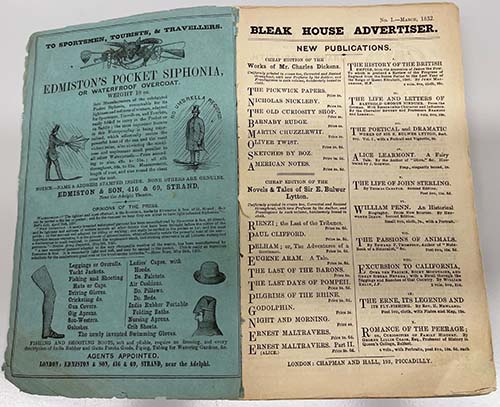By Patricia Reguyal, Archives Assistant
Bleak House was Charles Dickens’s ninth novel, and, according to Dickens scholar Paul Schlicke, “technically his most ambitious novel and widely held to be his masterpiece.” The novel had four important editions while Dickens was alive—as monthly serials from 1852 to 1853 (in twenty parts that came out in nineteen pamphlets because the nineteenth and twentieth parts were combined), the Cheap Edition of 1858, the Library Edition of 1868, and the Charles Dickens Edition of 1869.
The first edition of the novel, the monthly serialization in nineteen pamphlets, is one of the most exciting items in the SCA collection of rare books.
Bleak House had mixed reviews when it first came out. While the structure of the novel was praised, its forceful indictment of oppressive social institutions and its straightforward didacticism were criticized by some. But each serial part sold well and allowed Dickens to accumulate enough wealth for a contemporary to call him a “literary Croesus.”
While many of us are probably aware that Dickens’s novels were serialized when they first came out, it is still extraordinary to see these original pamphlets—their pale blue covers, thin sheets, and Victorian advertisements are highly evocative of the era.
The advertisements, in particular—the specific items, and their descriptions and illustrations—are remarkable. The advertisements were for Dickens’s books as well as other authors’ and from other publications, but also for a variety of merchandise that included, among others, the following: waterproof garments (“No umbrella required”!); a variety of hair products, including an actual head of hair; skin ointment (“These medicines excel all others in the cure of scrofula or king’s evil, glandular and other unnatural swellings, scurvy, leprosy, and all diseases of the skin.”); frocks, coats, and pelisses; cloaks, hoods, hats, and bonnets; Parr’s Life Pills (“They mildly and speedily remove all Skin Eruptions, Sallowness of Complexion, Nervous Irritability, Sick Head-Ache, Depression of Spirits, Irregularity, or general derangement of the system.”); chrystal spectacles and cough jujube lozenges; life insurance policies and loans; Rimmel’s toilet vinegar; a chest expander; pulmonic wafers that will give “perfect freedom from coughs in ten minutes”; shawls and needles and “papier mache elegancies”; mourning outfits; a self-acting pipe tube which is a “novelty in smoking”; wools and parasols.
An article published in 1970 argues that reading Bleak House as a novel, “all at once from cover to cover,” is a misreading, that serialization was essential to Dickens’s art, that “the slow, deliberate pace of publication, and the suspense which the monthly interruption of the narrative naturally aroused,” is vital to understanding its artistry and implications.
A slow and deliberate pace. The suspense of monthly interruptions. Living as we do in a world in which we can binge-watch one whole season of a show on a single afternoon, it is, for most of us, an effort to read Bleak House as a novel “all at once from cover to cover” and it is difficult to imagine reading it as a serial in the course of a year and a half.
These first edition pamphlets are powerful aids for us to envision a different way of reading and entertainment, a different way of engaging with our imagination, perhaps even a different way of relating to time.




